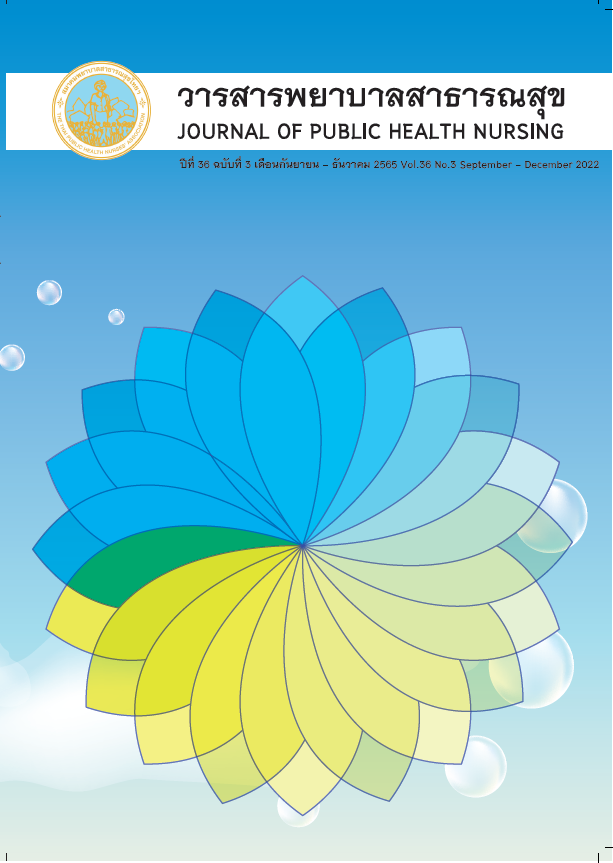The development of self-management supportive model for patient with silicosis
Keywords:
Self-management model, Silicosis patientsAbstract
The objective of this action research was to develop a self-management supportive model for silicosis patients and evaluate the outcomes of developed model. The 4 phases of model development included 1) Planning phase: Situational analysis and literature review was used to draft the self-management supportive model for silicosis patients 2) Action phase: competency of nurses responsible for silicosis patients (n=15) was enhanced and nursing care plan as well as self-management manual were developed. 3) Observation phase: outcomes were measured after the model was tested with 13 silicosis patients. 4) Reflection phase: feedback on problems and obstacles of developed model was used for model revision. The data was collected using In-depth interview, and questionnaire and was analyzed by using content analysis and descriptive statistics. The result of this research showed that there were 7 goals of the selfmanagement model in silicosis patients including 1) decreasing dyspnea and difficulty breathing, 2) complication prevention, 3) delay the progression of silicosis, 4) reducing stress and anxiety, 5) having family - centered care, 6) having channels for emergency care, and
7) adequate and balanced diet. Nurses have to support the self-management of the patients through providing advice, demonstration, and counseling. Evaluation of the outcomes showed that patients had the highest scores on self-management related to complication prevention, while self –management related to dyspnea and difficulty breathing decreasing was the lowest. Silicosis patients and nurse satisfied with the selfmanagement
model and patients had neither complication nor return to hospital before the appointment. This self-management supportive model could be used as practice
guideline for healthcare workers to improve quality of life for silicosis patients.
References
References
Cheepsattayakorn A, Cheepsattayakorn R. Silicosis-associated tuberculosis: management and control. JLPRR 2018; 5(5): 151-3. (in thai)
Baxter P, Aw T, Cockcroft A, Durrington P, Harrington J. Hunter's Diseases of Occupations, London: CRC Press; 2010.
Lopes-Pacheco M, Bandeira E, Morales M. Cell-Based Therapy for Silicosis. SCI 2016; 2016: 1-9.
Koeger A, Alcaix D, Rozenberg S, Bourgeois P: Occupational exposure to silicon and dermatopolymyositis.3 cases [Article in French]. Ann Med Interne (Paris) 1991; 142: 409-13.
Bureau of Occupational and Environmental Diseases. Report on the situation of disease and health hazards from occupation and environment. Department of Disease Control [Internet]. 2012 [cited 2022 Jan 14]. Available from: http://envocc.ddc.moph.go.th/uploads/situation/situation-report-2555.pdf
Bureau of Occupational and Environmental Diseases. Report on the situation of disease and health hazards from occupation and environment. Department of Disease Control [Internet]. 2017 [cited 2022 Jan 14]. Available from: http://envocc.ddc.moph.go.th/uploads/situation2/2561/2561_01_envocc_situation.pdf
Bureau of Occupational and Environmental Diseases. Report on the situation of disease and health hazards from occupation and environment. Department of Disease Control [Internet]. 2018 [cited 2022 Jan 14]. Available from: http://envocc.ddc.moph.go.th/uploads/situation/situation-report-2555.pdf
Ramakul K. Epidemiological Review of Silicosis in Thailand. Dis Control J 2008; 34: 109-17. (in thai)
Silanun K, Chaiear N, Rechaipichitkul W. Prevalence of silicosis instone carving workers being exposed toinorganic dust at Sikhiu District Nakhonratchasima Province, Thailand; preliminaryresults. J Med Assoc Thai 2017; 100(5): 598–602. (in thai)
Tang WK, Yip WC, Lum CM, Xiang YT, Lee E, Ungvari GS. Caregiving burden and quality of life of pneumoconiosis caregivers in Hong Kong. Heart &lung: ACC 2011; 40(5): 412-9.
Sairat P, Wattana C, Takviriyanun N. Effect of a self-management training program on functional performance, acute exacerbation and quality of life among patients’ chronic obstructive pulmonary disease. NJ 2014; 23-35. (in Thai)
Creer T. Self-management of chronic illness: Handbook of self-regulation. California: Academic; 2000. p. 601-29.
Kemmis S, McTaggart R. The Action Research Planer. 3rd ed. Victoria: Deakin University; 1998.
Ngamjarus C, Chongsuvivatwong V, McNeil E. n4Studies: Sample Size Calculation for an Epide-miological Study on a Smart Device Siriraj Med J. 2016; 68: 160-170.
Wang HQ, Jia JL, Jiang ZQ, Jin Q, Li DX, Ling RJ, et al. Analysis of Health Service Utilization and its Influencing Factors among Patients with Pneumoconiosis in China. BES 2021; 34(1): 83-8.
Han B, Yan B, Zhang J, Zhao N, Sun J, Li C. et al. The Influence of the Social Support on Symptoms of Anxiety and Depression among Patients with Silicosis. Sci. World J 2014; 2014: 1-6.
Wang HQ, Jia JL, Jiang ZQ, Jin Q, Li DX, Ling RJ, et al. Analysis of Health Service Utilization and its Influencing Factors among Patients with Pneumoconiosis in China. BES 2021; 34(1): 83-8.
Lenferink A, Brusse-Keizer M, van der Valk PD, Frith PA, Zwerink M, Monninkhof EM, et al. Self-management interventions including action plans for exacerbations versus usual care in patients with chronic obstructive pulmonary disease. Cochrane Database Syst Rev; 2017; 8: 011682. doi: 10.1002/14651858.CD011682.pub
Boonsung, P, Luksiri A, Suranprom P. Effectiveness of self-management educational program for chronic obstructive pulmonary disease patients at Rongkwang Hospital, Phrae Province, [Master’s thesis, Clinical Pharmacy program]. Chiang Mai: Chiang Mai University; 2012.
Role of pulmonary Rehabilitation in Silicosis.Physio- Pedia. Weblog [Internet]. 2021 [cited 2022 jan 19]. Available from: https://www.physio-pedia.com/Role_ ot_pulmomary_ ehabilitation_in
Lorig K, Holman H. Self-management education: History, definition, outcomes, and mechanisms. ABM 2003; 26(1): 1-7.
Klinklom S, Panuthai S, Nanasil P. Self-management behaviors and relate factors among older persons with benign prostatic hyperplasia [Master’s thesis, Nursing program]. Chiang Mai: Chiang Mai University; 2014.
Li P, Yu D, Tam S. The Lived Experience of Patients and Family Caregivers in Managing Pneumoconiosis. Qualitative Health Research. 2021 [Internet]. 2021 April 7 [cited 2022 Jan 14]. Available from: URL: http://www/cdc/gov/ncidoc/EID/eid.htm
Sutat P, Monhha K, Tharadol K, Benjamas C. The Effectiveness of a Self-management Program for Pulmonary Rehabilitation of Patients with Chronic Obstructive Pulmonary Disease THJPH 2017; 47(2): 200-21. (in thai)
Downloads
Published
Versions
- 2023-07-19 (3)
- 2022-08-31 (1)
How to Cite
Issue
Section
License
Copyright (c) 2022 Thai Public Health Nurses Association

This work is licensed under a Creative Commons Attribution-NonCommercial-NoDerivatives 4.0 International License.
บทความที่ตีพิมพ์และแผนภูมิรูปภาพถือเป็นลิขสิทธิ์ของวารสารพยาบาลสาธารณสุข (Thai Public Health Nurses Association)







